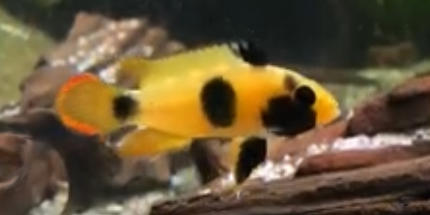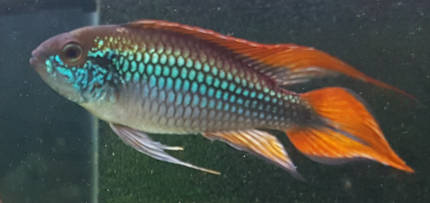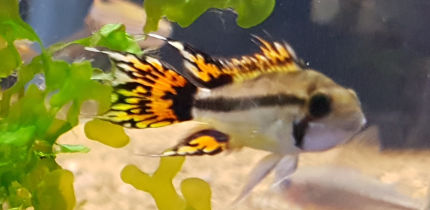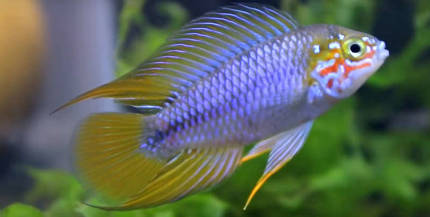About Apistogramma Nijsseni
Apistogramma Nijsseni, or Nijssen's dwarf cichlid, is a captivating freshwater fish native to northern Peru.
These small, vibrantly colored cichlids are known for their intricate patterns and adaptability to various aquatic environments.
In aquariums they thrive in warm slightly acidic water and displaying a range of behaviors from hiding in vegetation to exploring open spaces.
Aquarists like Apistogramma Nijsseni because they look amazing and are fun to watch with their interesting behaviors. They're a popular choice for those who want lively and good looking fish.
Apistogramma Nijsseni are also sometimes called the dwarf Panda Cichlid as the female has black patches on her body similar to that of a panda.
Apistogramma Nijsseni Profile
Origin: Río Ucayali in Loreto Region, northern Peru.
Size: Female: up to 2.5 inches (6.5 cm), Male: up to 3 inches (7.5 cm).
Minimum tank size: 20 gallons (75 litres).
Tank region: Bottom half of the tank.
Water temperature:75 - 82 °F (24 - 28 °C)
Water conditions: PH between 5 to 7 is desirable. Soft water with a low TDS is preferred.
Difficulty to keep: Beginner to intermediate level
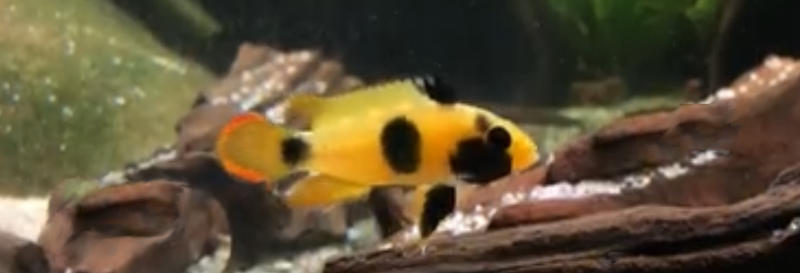
Apistogramma Nijsseni Natural Habitat
Apistogramma Nijsseni originate from tributaries of the Río Ucayali in Loreto Region, northern Peru including the Río Carahuayte and Río Yavarí. These little, colorful fish like to live in slow-moving streams and quiet tributaries.
In their natural home, Apistogramma Nijsseni are found among lots of plants, roots, fallen branches, and leaves. This creates a cozy hiding place for them and a good territory. The floor of these streams is usually sandy or muddy.
These fish are good at adapting to changes in their environment. For example, when the water level drops during the dry season, they might move to deeper pools for safety. But when it's rainy, they get more space to swim, eat, and spawn.
Apistogramma Nijsseni Behaviour And Personality
Apistogramma Nijsseni have really interesting personalities and behaviors that make them stand out in an aquarium. These fish are full of energy and have some unique habits.
One notable aspect of Apistogramma Nijsseni's personality is its territorial nature. Males can be quite territorial, establishing and defending their territories within the aquarium. This territorial behavior often increases during breeding periods when males become more protective of their chosen spawning sites.
Despite their territorial tendencies, Apistogramma Nijsseni are also known for their curious and inquisitive nature. They are active swimmers, constantly exploring their environment and investigating any changes or new additions to their surroundings. This curiosity adds an element of activity to the aquarium as these fish dart in and out of hiding spots, interact with tank mates, and investigate their territory.
Overall the personality and behavior of Apistogramma Nijsseni make them captivating additions to aquariums.
Apistogramma Nijsseni Male vs Female
Distinguishing between male and female Apistogramma Nijsseni involves observing several physical and behavioral traits.
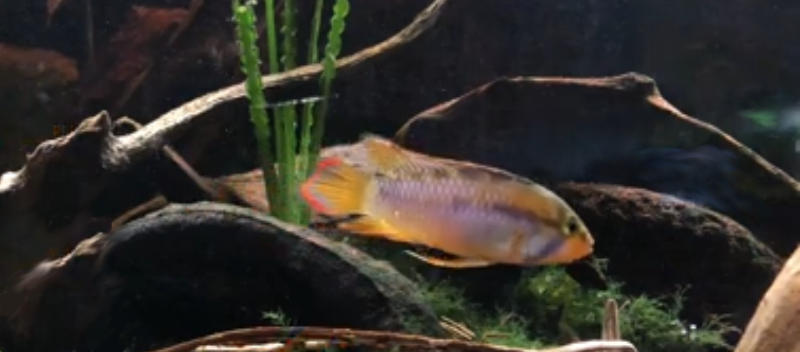
Generally males and females exhibit differences in coloration, body size, and fin shape.
One of the most noticeable distinctions is in their coloring. Male Apistogramma Nijsseni typically display more vibrant and intense colors compared to females.
Once mature males have light blue to aqua blue coloration on the main portion of their body with yellow on the surrounds and fins with a orange highlight at the end of their tail.
Female are mainly yellow with black splotches on their body and have the same orange band at the end of their tales.
Males often showcase brighter hues, especially during breeding periods, when their colors become even more pronounced to attract females.
Body size can also vary between males and females with males typically being slightly larger and more robust than females. This size difference is most evident when the fish reach maturity. Males develop a more elongated body shape compared to the rounder shape of females.
The shape of the fins can also help to determine the sex of Apistogramma Nijsseni. Males often have more elongated dorsal and anal fins, which may be enhanced with extensions or filaments. In contrast females tend to have shorter and more rounded fins.
Behaviorally males may exhibit more territorial and aggressive tendencies, especially during breeding periods when they defend their territories and court females.
Females on the other hand may display more submissive behaviors, particularly when preparing to spawn or caring for their offspring.
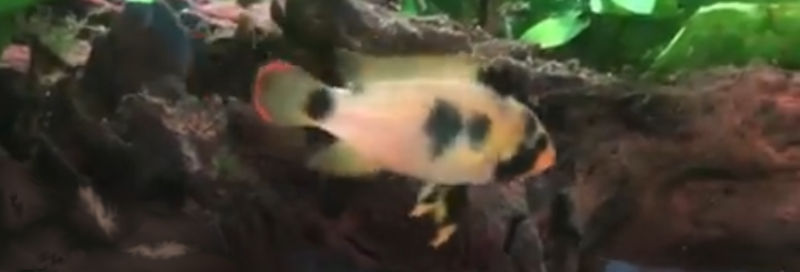
Apistogramma Nijsseni Diet And What To Feed Them
In the wild, Apistogramma Nijsseni eats a mix of small things like bugs, insect larvae, and tiny creatures in the water and on the bottom of streams. This variety of food keeps them healthy and lively.
If you want to keep these little colorful fish in top shape make sure to give them the right food.
Start with good quality flakes or pellets made for small cichlids. These have everything Apistogramma Nijsseni need to stay well fed and healthy so they can show off their pretty colors.
Mix things up with live or frozen treats like brine shrimp, daphnia, or bloodworms. This variety is similar to what they eat in the wild and helps them grow big and beautiful.
Feed them small meals often. Do not overfeed as uneaten food can foul the water leading to poor water conditions if the aquarium is not cleaned and well maintained.
For more information on what to feed you Apistogrammas see our article Best Foods For Apistogrammas.
Apistogramma Nijsseni Aquarium Setup
Tank Size
The ideal tank size for Apistogramma Nijsseni largely depends on the number of fish you plan to keep and the setup of the aquarium. Generally, a tank size of at least 20 gallons (75 litres) is recommended for a pair of Apistogramma Nijsseni.
Having a larger tank provides more space for these fish to establish territories and reduces the likelihood of aggressive behavior, especially among males. Additionally, a larger volume of water helps maintain stable water parameters, which is crucial for the health and well-being of the fish.
If you plan to keep a breeding pair or multiple pairs of Apistogramma Nijsseni, consider providing even more space to accommodate their territorial behaviors and potential spawning activities.
Aquarium Layout
If you want to make your aquarium feel like home for Apistogramma Nijsseni, add things like driftwood, plants, and sand substrate.
The driftwood and plants not only mimics their natural environment but also breaks up line of sight to provide different zones or territories withing the aquarium – which helps prevent or minimise aggression.
Keep the water warm and slightly acidic, similar to the streams they inhabit in South America.
Doing these things will help these little cichlids stay happy and healthy in your aquarium.
If you would like more information on managing aggression see - Apistogramma Aggression And How To Reduce It.
Apistogramma Nijsseni Tank Mates
Avoiding larger or aggressive fish species that may intimidate or outcompete Apistogramma Nijsseni is advisable.
Generally Apistogrammas appreciate some tank mates, even just a small school of tetras to serve as dither fish will help them feel more secure.
Small and peaceful species like tetras such as Ember Tetras, Loreto Tetras (and many more), as well as Dwarf Pencilfish are generally good choices for Apistogramma Nijsseni tank mates. These fish occupy different levels of the aquarium, which helps minimize competition for space.
For more detail on selecting appropriate Apistogramma tank mates check out our detailed article, Apistogramma Tank Mates.
Conclusion
Apistogramma Nijsseni are not too difficult to keep and are popular due to their striking colors which make them visually appealing additions to aquariums. They also exhibit fascinating behaviors, which make them interesting to observe.
Their relatively peaceful nature and compatibility with various tank mates also make them versatile choices for community aquariums.
Basically, Apistogramma Nijsseni are popular because they are pretty, fun to watch, and not too difficult to take care of.
